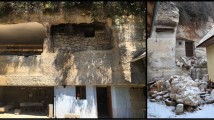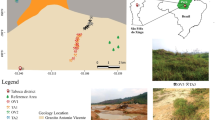Abstract
High levels of SO2 and particulate pollution enable the rapid development of gypsum-rich weathering crusts in Budapest. Two types of white crusts, thin and thick ones, and two forms of black crusts, laminar and framboidal ones, were studied in limestone buildings of the parliament and Citadella. The percentage of crust cover and damage categories were documented on selected walls. Petrographic, XRD, XRF and sulphur isotope analyses were performed under laboratory conditions to understand the mechanism of crust formation. White crusts found both on exposed and sheltered walls display a calcite-rich layer with gypsum, while black crusts are enriched with gypsum. The sulphur isotopic composition of white and black crusts overlaps, but the crusts are slightly enriched in heavy isotopes compared to rainwater. S content, Si/Al ratios and particulates in black crusts suggest that air pollution (SO2, dust) contributes to black crust formation. The accumulation of sulphur and Zn enrichment of white crusts were also documented indicating that under high pollution levels, even these compound can accumulate on exposed facades.









Similar content being viewed by others
References
Amoroso GG, Fassina V (1983) Stone decay and conservation. Elsevier, Amsterdam, pp 1–453
Antill SJ, Viles HA (1999) Deciphering the impacts of traffic on stone decay in Oxford: some preliminary observations from old limestone walls. In: Jones MS, Wakefield RD (eds) Aspects of stone weathering, decay and conservation. Imperial College Press, London, pp 28–42
Ausset P, Del Monte M, Lèfevre RA (1999) Embryonic sulphated black crusts on carbonate rocks in atmospheric simulation chamber and in the field: role of carbonaceous fly-ash. Atmos Environ 33:1525–1534
Bonazza A, Sabbioni C, Ghedini N, Favoni O, Zappia G (2004) Carbon data in black crusts on European monuments. In: Saiz-Jimenez C (ed) Air pollution and cultural heritage. Taylor & Francis, London, pp 39–47
Bonazza A, Sabbioni C, Ghedini N (2005) Quantitative data on carbon fractions in interpretation of black crusts and soiling on European built heritage. Atmos Environ 39:2607–2618
Cultrone G, Rodriguez-Navarro C, Sebastian E (2004) Limestone and brick decay in simulated polluted atmosphere: the role of particulate matter. In: Saiz-Jimenez C (ed) Air pollution and Cultural Heritage. Taylor & Francis, London, pp 141–145
Del Monte M, Rossi P (1997) Fog and gypsum crystals on building materials. Atmos Environ 31:1637–1646
Del Monte M, Vittori O (1985) Air pollution and stone decay: the case of Venice. Endeavoir 9:117–122
Del Monte M, Ausset P, Forti P, Lefèvre RA, Tolomelli M (2001) Air pollution records on selenite in the urban environment. Atmos Environ 35:3885–3896
Do J (2000) Untersuchung der Verwitterung von Fassaden aus Naturstein—Vergleich an den Gebäuden der Museumsinsel in Berlin. Ph.D. University of Berlin
Fassina V, Favaro M, Naccari A (2002) Principal decay patterns on Venetian Monuments. In: Siegesmund S, Weiss T, Vollbrecht A (eds) Natural stones, weathering phenomena, conservation strategies and case studies. Geological Society, London Special Publication 205:381–391
Fitzner B, Heinrichs K (2002) Damage diagnosis at stone monuments—weathering forms, damage categories and damage indices. In: Prykril R, Viles (eds) Understanding and managing stone decay. Carolinum Press, Prague, pp 11–56
Hüpers A, Müller C, Siegesmund S, Hoppert M, Weiss T, Török Á (2005) Kalksteinverwitterung—die Zitadella und das Parlamentsgebäude in Budapest. In: Siegesmund S, Auras M, Snethlage R (eds) Stein Zerfall und Konservierung. Edition Leipzig, Leipzig, pp 201–209
Kieslinger A (1932) Zerstörung an Steinbauten—Ihre Ursachen und ihre Abwehr. Verlag Deuticke, Leipzig-Wien, pp 1–346
Klemm W, Siedel H (1999) Schwefelisotopenanalyse von bauschädlichen Sulfatsalzen an historischen Bauwerken. Wissenschaftliche Mitt 8/99:1–101
Klemm W, Siedel H (2002) Evaluation of the origin of sulphate compounds in building stone by sulphur isotope ratio. In: Siegesmund S, Weiss T, Vollbrecht A (eds) Natural stones, weathering phenomena, conservation strategies and case studies. Geological Society, London Special Publication 205:419–429
Krumbein, WE (1992) Colour changes of building stones and their direct and indirect biological causes. In: Rodriguez JD, Henriquez F, Jeremias FT (eds) Seventh international congress on deterioration and conservation of stone, Lisbon, pp 443–452
Lefèvre RA, Ausset P (2002) Atmospheric pollution and building materials: stone and glass. In: Siegesmund S, Weiss T, Vollbrecht A (eds) Natural stones, weathering phenomena, conservation strategies and case studies. Geological Society, London Special Publication 205:329–345
McAlister JJ, Smith BJ, Török Á (2006) Element partitioning and potential mobility within surface dusts on buildings in a polluted urban environment, Budapest. Atmos Environ (in press)
Maravelaki-Kalaitzaki P, Biscontin G (1999) Origin, characteristics and morphology of weathering crusts on Istria stone in Venice. Atmos Environ 33:1699–1709
Moropoulou A, Bisbikou K, Torfs K, Van Grieken R, Zezza F, Macri F (1998) Origin and growth of weathering crusts on ancient marbles in industrial atmosphere. Atmos Environ 32:967–982
Neumann HH, Steiger M, Wassmann A, Dannecker W (1993) Aufbau und Ausbildung schwarzer Gipskrusten und damit zusammenhängender Gefügeschäden von Naturwerksteinen am Beispiel des Leineschlosses (Hannover). Jahresber Steinzerfall Steinkonservierung 1991:150–167
Sabbioni C (1995) Contribution of atmospheric deposition to the formation of damage layers. Sci Total Environ 167:49–56
Sabbioni C (2003) Mechanism of air pollution damage to stone. In: Brimblecombe P (ed): The Effects of air pollution on the built environment. Air Pollut Rev 2:63–88
Primerano P, Marino G, Di Pasquale S, Mavilia L, Corigliano F (2000) Possible alteration of monuments caused by particles emitted into the atmosphere carrying strong primary acidity. Atmos Environ 34:3889–3896
Rhan KA (1976) Silicon and aluminium in atmospheric aerosols: crust–air fractionation. Atmos Environ 10:597–601
Rodriguez-Navarro C, Sebastian E (1996) Role of particulate matter from vehicle exhaust on porous building stones (limestone) sulfation. Sci Total Environ 187: 79–91
Saiz-Jimenez C (1993) Deposition of airborne organic pollutants on historic buildings. Atmos Environ 27B:77–85
Saiz-Jimenez C (1995) Microbial melanins in stone monuments. Sci Total Environ 167:273–286
Smith BJ (1996) Scale problems in interpretation of urban stone decay. In: Smith BJ, Warke PA (eds) Processes of urban stone decay. Donhead, London, pp 3–18
Smith BJ, Whalley WB, Fassina V (1988) Elusive solution to monumental stone decay. New Sci 1615:49–53
Smith BJ, Török Á, McAlister JJ, Megarry J (2003) Observations on the factors influencing stability of building stones following contour scaling: a case study of the oolitic limestones from Budapest, Hungary. Build Environ 38:1173–1183
Steiger M (1991) Die anthropogenen und natürlichen Quellen urbaner und mariner Aerosole, charakterisiert und quantifiziert durch Multielementanalyse und chemische Receptormodelle. Ph.D. University of Hamburg, Hamburg
Thornbush M, Viles H (2004) Integrated digital photography and image processing for the quantification of colouration on soiled limestone surfaces in Oxford, England. J Cult Herit 5:285–290
Torfs KM, Van Grieken RE (1997) Chemical relations between atmospheric aerosols, deposition and stone decay layers on historic buildings at the Mediterranean coast. Atmos Environ 31:2179–2192
Trudgill ST, Viles HA, Inkpen R, Moses C, Gosling W, Yates T, Collier P, Smith DI, Cooke RU (2001) Twenty-year weathering remeasurements at St Paul’s Cathedral, London. Earth Surf Processes Landf 26:1129–1142
Török Á (2002) Oolitic limestone in polluted atmospheric environment in Budapest: weathering phenomena and alterations in physical properties. In: Siegesmund S, Weiss T, Vollbrecht A (eds) Natural stones, weathering phenomena, conservation strategies and case studies. Geological Society, London, Special Publications 205:363–379
Török Á (2003) Surface strength and mineralogy of weathering crusts on limestone buildings in Budapest. Build Environ 38:1185–1192
Török Á (2005) Gypsum-induced decay on the limestone buildings in the urban environment of Budapest. Int J Restor Build Monum 11:71–78
Török Á (2006a) Hungarian travertine: weathering forms and durability. In: Fort R, Alvarez de Buego M, Gomez-Heras M, Vazquez-Calvo C (eds) Heritage weathering and conservation, Taylor & Francis/Balkema, London, vol I:199–204
Török Á (2006b). Black crusts on travertine: factors controlling development and stability. Build Environ (in press)
Török Á, Rozgonyi N (2004) Mineralogy and morphology of salt crusts on porous limestone in urban environment. Environ Geol 46:323–339
Török Á, Siegesmund S, Müller C, Hüpers A, Hoppert M, Weiss T (2006). Differences in texture, physical properties and microbiology of weathering crust and host rock: a case study of the porous limestone of Budapest (Hungary). In: Prikryl R, Smith BJ (eds) Building stone decay. Geological Society Special Publications, London (in press)
Viles HA (1994) Observations and explanations of stone decay in Oxford, UK. In: Thiel MJ (ed) Conservation of stone and other materials, vol I, Causes of disorders and diagnosis. E & FN Spon—RILEM, London, pp 115–120
Winkler EM (1970) The importance of air pollution in the corrosion of stone and metals. Eng Geol 4:327–334
Warscheid T, Braams J (2000) Biodeterioration of stone: a review. Int Biodeterior Biodegradation 46:343–368
Acknowledgments
The financial support of the German-Hungarian Scientific co-operation (DAAD-MÖB project no. 30) is acknowledged. This work was also partly financed by the Bolyai János research grant (BO/233/04, ÁT) and by the Hungarian Science Found (OTKA, grant no. K63399, ÁT).
Author information
Authors and Affiliations
Corresponding author
Rights and permissions
About this article
Cite this article
Siegesmund, S., Török, A., Hüpers, A. et al. Mineralogical, geochemical and microfabric evidences of gypsum crusts: a case study from Budapest. Environ Geol 52, 385–397 (2007). https://doi.org/10.1007/s00254-006-0588-3
Received:
Accepted:
Published:
Issue Date:
DOI: https://doi.org/10.1007/s00254-006-0588-3




